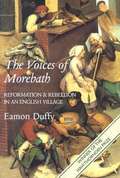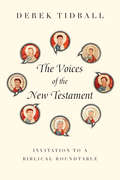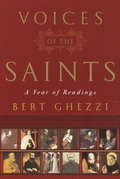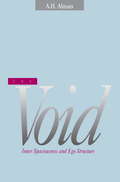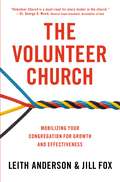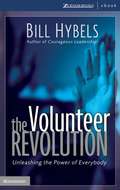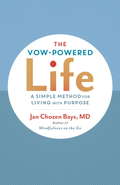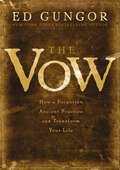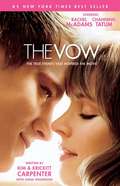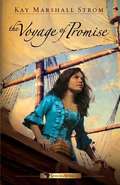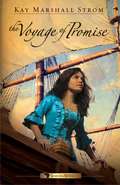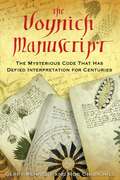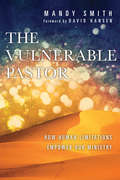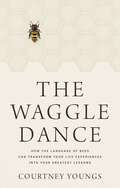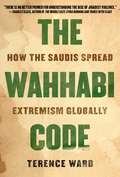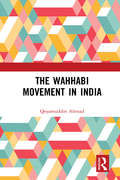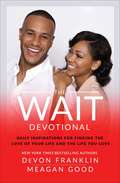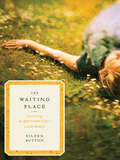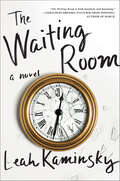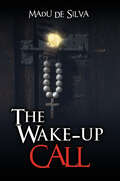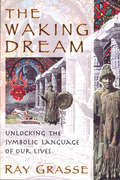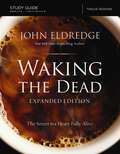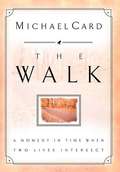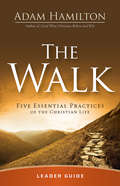- Table View
- List View
The Voices of Morebath: Reformation and Rebellion in an English Village
by Eamon DuffyThis is a book about a sixteenth-century country priest, and the extraordinary records he kept. It deals with ordinary people in an unimportant place, whose claim to fame is that they lived through the most decisive revolution in English history, and had a priest who wrote everything down.
The Voices of the New Testament: Invitation to a Biblical Roundtable
by Derek TidballIs there a single message of the New Testament? Theologians seek to bring coherence to the diverse teachings and approaches found in the New Testament, but this is no simple task. While the New Testament writers are clearly all concerned with the story and significance of Jesus, the New Testament itself is a collection of twenty-seven books written by at least nine different authors who address individuals or groups in several different locations over a number of years. This variety offers a challenge, yet also adds richness to our understanding of the Christian faith and its fundamental beliefs. Envisioning a roundtable conversation among the New Testament writers, Derek Tidball reveals how much these authors have in common while permitting them to emphasize their distinct contributions in articulating the message of good news. The result of eavesdropping on their imagined discussion is a fascinating introduction to the diversity and unity of the New Testament.
The Voices of the Saints
by Bert GhezziThe inspiring stories of 365 holy men and women-from the best known to some of the most obscure-come to life in an engaging collection of biographical profiles, quotations from the saints themselves, meditations, and prayers.Voices of the Saints opens with an instruction from Saint Philip Neri: "The best preparation for prayer is to read the lives of the saints, not from mere curiosity, but quietly and with recollection a little at a time. And to pause whenever you feel your heart touched with devotion."With these words of faith and wisdom as his guiding principle, Bert Ghezzi presents the lives of such familiar and beloved saints as Saint Peter and Saint Catherine of Siena; Saint Jerome and Saint Thérèse of Lisieux; of humble, little-known figures like Felix of Nola, Pelagia the Penitent, and Leonard of Port Maurice; and of sainted men and women associated with a particular place, including Margaret of Scotland, Rose of Lima, Elizabeth Ann Seton, and Junípero Serra. In lively profiles written for contemporary readers, Ghezzi chronicles their journeys of faith and their contributions to the vitality of the Church. The voices of the saints resound throughout the book, in quotations drawn from their own writings, the works of biographers, and the recollections of witnesses.Readers can use Voices of the Saints in several different ways. Organized alphabetically, it serves as a helpful, easy-to-use dictionary. It also features a day-by-day numbering system, ideal for daily readings; notations at the end of each entry, enabling the exploration of the lives in historical order; an index that highlights particular themes (including the intriguing "Porcupine Saints"), and a calendar of saints' days. A fascinating look at disparate and unusual lives-each one a rich source of illumination, inspiration, encouragement, and motivation-along with prayers and meditations, Voices of the Saints is a valuable companion for members of Catholic, Episcopal, and other traditional churches, and an enlightening introduction to the saints for general readers.From the Hardcover edition.
The Void: Inner Spaciousness and Ego Structure
by A. H. AlmaasIn this book Almaas brings together concepts and experiences drawn from contemporary object relations theory, Freudian-based ego psychology, case studies from his own spiritual practice, and teaching from the highest levels of Buddhist and other Eastern practices. He challenges us to look not only at the personality and the content of the mind, but also at the underlying nature of the mind itself.
The Volunteer Church: Mobilizing Your Congregation for Growth and Effectiveness
by Leith Anderson Jill FoxWorking with volunteers can be a rewarding and exciting experience—for them as well as for those who recruit, train, and maintain their services. However, if church leaders are honest, they know there are times that it can be frustrating. They know that volunteers are essential, vital to creating growth and new ministries, and are the key to introducing youth and children to Jesus Christ. They have the welcoming smiles at the door, they serve the food, pray for needs, stuff bulletins, organize missions trips, and on and on. If they want to see their church grow, it must be a volunteering church, a church that runs on volunteers. The Volunteer Church was developed out of the ministry of Leith Anderson at Wooddale Church in Eden Prairie, Minnesota, where a vital and vibrant volunteer program boasting 4,000 participants grew under the leadership of Jill Fox. The principles and training have been applied in churches of all sizes and denominations in seminar settings across the country as well as at Wooddale Church. In The Volunteer Church, leaders will Learn how to effectively recruit and train volunteers Discover how to build sustainable, long-lasting ministries led by volunteers Find methods for encouraging and maintaining your volunteers for success Know how to build teams of volunteers Understand how to find the right service that fits a willing volunteer If you lead a church and are exhausted by the lack of volunteer help, or if you are a volunteer and dream of adding numbers to your team, this book is for you. If you are on a church staff and know that a new ministry is needed but volunteers and training are required to make it happen, here you will find the resources to recruit, inspire, train, and maintain the church’s most vital workforce.
The Volunteer Revolution: Unleashing the Power of Everybody
by Bill HybelsPastor Bill Hybels believes that there is a new reality in America. The church has entered an era of growth and unprecedented spiritual opportunity to share the Gospel, yet at the same time we face a shrinking economy and a world in crisis. This poses a great resource challenge for the church. In order to reach out to people who are spiritually hungry, the church needs more people to be equipped to serve others. Hybels passionately believes the key to the future of the church is the equation "X (paid staff) + Y (volunteers) = Z (bearing much fruit for God’s glory)." Churches cannot afford to continue hiring more and more staff with limited budgets. The key to resourcing the church is what Hybels calls "the Y factor." The Y factor is the pool of volunteers in every church. The great need of the church is to grow the church’s volunteer base through the equipping ministry of church staffs. As churches recover the message of Ephesians 4:11-12 to "equip God’s people for works of service" they will launch a Volunteer Revolution. People are just waiting to discover the gifts and passions that God has given them to serve others and then be invited to use those gifts and passions through the local church in order to advance the kingdom of God on Earth. Hybels believes that every church staff should be helping people discover their spiritual gifts, passions and place of service in order to meet the growing needs in our churches and world. Hybels makes a clarion call to move beyond volunteer retention to volunteer acquisition. By attracting, connecting, training, and sustaining volunteers, churches will mobilize people into places of service that will bring new meaning to their lives and understand why God put them on planet Earth. Hybels also outlines how we can build lifelong volunteers in the church through community, celebration, and commendation.
The Vow of the Ikeda Kayo-kai: Encouragement for young Women
by Daisaku IkedaIn furtherance of his vision of fostering dialogue and solidarity for peace, Ikeda has founded a number of independent, nonprofit research institutes that develop cross-cultural, interdisciplinary collaboration on diverse issues: the Boston Research Center for the 21st Century, the Toda Institute for Global Peace and Policy Research and the Institute of Oriental Philosophy.
The Vow-Powered Life: A Simple Method for Living with Purpose
by Jan Chozen BaysA vow is like a GPS system for your life. When taken on mindfully it can be a source of surprising wisdom and powerful energy, enabling you to accomplish things you never dreamed possible. It can have profound effects even beyond the original intention--and it can even live on after you're gone. A vow can be as small as the aspiration to smile at someone at least once every day, or it can be as big as marriage; it can be as personal as deciding to be mindful whenever you pick up the phone, or it can be as universal as a commitment to save all sentient beings. But whatever its inspiration, when it's done with conscious intention a vow becomes a conduit for the energy of your life.In this guide to the vow-directed life, Jan Chozen Bays provides a wealth of practical exercises to use for formulating and implementing vows of your own and for using them to navigate your life with honesty and compassion.
The Vow: How a Forgotten Ancient Practice Can Transform Your Life
by Ed GungorIn his first release since the best-selling There is More to the Secret, Ed Gungor challenges the church to return to authenticity and community. Over and over again in scripture Christians are encouraged to "make vows to the Lord" (e.g., Psalm 76:11). Is it possible that making vows-- intentionally inserting various Christian practices into our lives-- would have great value to 21st-century Christians? What if we thoughtfully and publicly articulated vows before God and those we love? Would it help our lives take on the tone of the eternal? Has something been lost in the openness of the 21st century? The answer is yes! Gungor says: "Vow-making is an old trail that was very familiar to the ancients who have gone before us, but is virtually unknown for we moderns. As I have wandered down this path, it has been both intriguing and empowering, and, on another level, just plain dangerous. But I really think it's leading somewhere. That's the why of this writing."
The Vow: The True Events That Inspired the Movie
by Kim Carpenter Krickitt Carpenter Dana WilkersonLife as Kim and Krickitt Carpenter knew it was shattered beyond recognition on November 24, 1993. Two months after their marriage, a devastating car wreck left Krickitt with a massive head injury and in a coma for weeks. When she finally awoke, she had no idea who Kim was. With no recollection of their relationship and while Krickitt experienced personality changes common to those who suffer head injuries, Kim realized the woman he had married essentially died in the accident. And yet, against all odds, but through the common faith in Christ that sustained them, Kim and Krickitt fell in love all over again. Even though Kim stood by Krickitt through the darkest times a husband can ever imagine, he insists, "I'm no hero. I made a vow. " Now available in trade paper with a new chapter and photo insert, The Vow is the true story that inspired the major motion picture of the same name starring Rachel McAdams (The Notebook), Channing Tatum (Dear John), Sam Neill (Jurassic Park), and Academy Award winner Jessica Lange.
The Voyage of Promise
by Kay Marshall StromShe is safe, and she is free . . . but she is still alone. Slavers burst into Grace Winslow's life with guns blazing and tear her family apart forever. She watches in anguish as her husband is led in chains aboard a tightly packed slave ship bound for America. An old enemy has a more sinister plan for Grace and prepares her for a different kind of servitude in London. But Grace will not be enslaved. And she will not give up on the man she loves. In her determination to be reunited with her husband, she finds God reaching out to her.
The Voyage of Promise
by Kay Marshall StromSlavers burst into Grace Winslow's life with guns blazing and tear her family apart forever. She watches in anguish as her husband is led in chains aboard a tightly packed slave ship bound for America. An old enemy has a more sinister plan for Grace and prepares her for a different kind of servitude in London. But Grace will not be enslaved. And she will not give up on the man she loves. In her determination to be reunited with her husband, she finds God reaching out to her.
The Voynich Manuscript: The Mysterious Code That Has Defied Interpretation for Centuries
by Gerry Kennedy Rob ChurchillAn examination of the many theories surrounding this enigmatic text, apparently written in code• Reveals the connections between this work and the Cathars, Roger Bacon, and John Dee • Explains the cryptanalysis methods used in attempts to break the code • Includes color images from the manuscript juxtaposed with other medieval writings Since its discovery by Wilfrid Voynich in an Italian monastery in 1912, the Voynich Manuscript has baffled scholars and cryptanalysists with its unidentifiable script and bizarre illustrations. Written in an unknown language or an as yet undecipherable code, this medieval manuscript contains hundreds of illustrations of unknown plants, cosmological charts, and inexplicable scenes of naked “nymphs” bathing in a green liquid that some interpret as a symbolic depiction of human reproduction and the joining of the soul with the body. Gerry Kennedy and Rob Churchill explore the mystery surrounding the Voynich Manuscript, examining the many existing theories about the possible authors of this work and the information it may contain. They trace the speculative history of the manuscript and reveal those who may be connected to it, including Roger Bacon, John Dee, and the Cathars. With the possibility that it may be a lost alchemical text or other esoteric work, this manuscript remains one of the most intriguing yet enigmatic documents ever to have come to light. Gerry Kennedy is a freelance writer and has produced a number of BBC Radio 4 programs, including one on the Voynich Manuscript in 2001. Rob Churchill is a professional writer who has written scripts for many production companies, including the BBC and Thames Television. Both authors were consultants for the BBC/Mentorn Films documentary The Voynich Mystery. They live in London.
The Vulnerable Pastor: How Human Limitations Empower Our Ministry
by Mandy SmithMissio Alliance Essential Reading List of 2015Hearts Minds Bookstore's Best Books of 2015, For Church LeadersProdigalThought.net's Top Reads of 2015Englewood Review of Books Best Books of 2015, PraxisLeadership Journal's
The Waggle Dance: How the Language of Bees Can Transform Your Life Experiences into Your Greatest Lessons
by Courtney YoungsThe Waggle Dance offers advice and mentorship in a humble and intimate way, using first-person narratives, tender letters to a child, Bible verses, and thought-provoking questions.Simply put, a waggle dance is how bees share information to help each other survive. In The Waggle Dance, Courtney Youngs shares important lessons learned from her own mentors and life experiences. In a playful, storytelling style, Courtney cuts through the confusion in life and helps us see clearly the rich rewards our experiences can bring us. Youngs&’s stories each contain a hopeful message, which will motivate you to think better, do better, be better. You will learn that When you&’re stuck in the past, just keep moving forward. When your path feels long, remember that our paths are seldom straight. Life is for the figuring it out—the loving, the messing up, and the waking up every day grateful that you get the chance to try it all again. Using the theory that hard seasons are our best teachers, Courtney talks about death, divorce, new careers, unlikely relationships, and her journey of becoming a mom. She introduces readers to some of the most influential people in her life and shares her discoveries in faith, friendship, and everything in between. Each chapter ends with motherly advice in the form of a letter written directly to her son, &“Little Bee.&” Her approach is one of humility, as a learner and not an expert who has it all figured out. The Waggle Dance comes from the perspective of a trusted friend, someone to help you see your way through the hard times in life—with a few laughs thrown in.
The Wahhabi Code: How the Saudis Spread Extremism Globally
by Terence WardAn Eye-Opening, Concise Look at the Source of the Current Wave of Terrorism, How it Spread, and Why the West Did Nothing Lifting the mask of international terrorism, Terence Ward reveals a sinister truth. Far from being “the West’s ally in the War on Terror,” Saudi Arabia is in reality the largest exporter of Wahhabism—the severe, ultra-conservative sect of Islam that is both Saudi Arabia’s official religion and the core ideology for international terror groups such as ISIS, al-Qaeda, the Taliban, and Boko Haram. Over decades, the Saudi regime has engaged in a well-crafted mission to fund charities, mosques, and schools that promote their Wahhabi doctrine across the Middle East and beyond. Efforts to expand Saudi influence have now been focused on European cities as well. The front lines of the War of Terror aren’t a world away; they are much closer than we can imagine. Terence Ward, who has spent much of his life in the Middle East, gives his unique insight into the culture of extremism, its rapid expansion, and how it can be stopped.
The Wahhabi Movement in India
by Qeyamuddin AhmadFounded by Sayyid Ahmad (1786-1831) of Rae Bareli, the Wahhabi Movement in India was a vigorous movement for socio-religious reforms in Indo-Islamic society in the nineteenth century with strong political undercurrents. It stood for a strong affirmation of Tauhid (unity of God), the efficacy of ijtihad (the right of further interpretation of the Quran and the Sunnah, or of forming a new opinion by applying analogy) and the rejection of bid'at (innovation). It remained active for half a century.Sayyid Ahmad's writings show an awareness of the increasing British presence in the country and he regarded British India as a daru'l harb (abode of war). In 1826 he migrated and established an operational base in the independent tribal belt of the North Western Frontier area. After his death in the battle of Balakote, the Movement slackened for some time but his adherents particularly Wilayet Ali and Enayat Ali of Patna revived the work and broad-based its activities.The climax of the Movement was reached in the Ambeyla War (1863) during which the English army suffered serious losses at the hands of the Wahhabis. This led the Government to take stern measures to suppress the Movement. Investigations were launched, the leaders were arrested and sentenced to long-term imprisonments and their properties confiscated. That broke the back of the Movement but it continued to be a potential source of trouble to the government.The Movement does not fit in neatly in any one of the groups and categories into which the history of the early resistance to British rule has been divided by some of the writers on the subject. It cut across some of them time-wise and theme-wise. The existing studies on the subject do not offer a comprehensive profile of the Movement and fail to analyse its nature and the reasons for its failure politically.This well researched study drawing on a vast array of contemporary records, many of them for the first time, seeks to fill this gap and presents an integrated account of the rise and growth of the Movement, its operation over the entire area and period of its existence, its impact and reasons for its failure. Please note: This title is co-published with Manohar Publishers, New Delhi. Taylor & Francis does not sell or distribute the Hardback in India, Pakistan, Nepal, Bhutan, Bangladesh and Sri Lanka
The Wait Devotional: Daily Inspirations for Finding the Love of Your Life and the Life You Love
by Meagan Good DeVon FranklinA daily devotional based on the New York Times bestselling The Wait, filled with inspiring readings about how having the patience to wait for God&’s best—instead of grasping for what you want right now—can transform your life.In The Wait, DeVon Franklin and Meagan Good, a Hollywood power couple who famously saved sex for marriage, shared the life-changing message that waiting—rather than rushing—can be the key for finding the person you&’re meant to be with. Now, their powerful message is reflected again in The Wait Devotional. Filled with scripture, prayers, and DeVon and Meagan&’s trademark conversational style, this 90-day devotional is packed with real-time advice for men and women trying to successfully navigate the ins and outs of dating, love, and relationships. You&’ll discover how waiting for everything—from sex to getting engaged—can transform your entire life by giving you greater patience, joy, peace, healing, faith, and love. Whether you&’re waiting for the right person to come along or you&’re searching for the strength to put intimacy on hold, The Wait Devotional can help you slow down and trust in God&’s perfect timing, day by day.
The Waiting Place
by Eileen ButtonSome of the most priceless gifts can be discovered while waiting for something else.We all spend precious time just waiting. We wait in traffic, grocery store lines, and carpool circles. We wait to grow up, for true love, and for our children to be born. We even wait to die. But while we work hard at this business of living, life can sometimes feel like one long, boring meeting. Even today, with instant gratification at our techno-laced fingertips, we can't escape the waiting place. Somehow, in between our texting and tweeting and living and dying, we end up there again and again.In the voice of an old friend or a wise-cracking sister, Eileen Button takes us back to the days of curling irons and camping trips, first loves and final goodbyes, big dreams and bigger reality checks. With heart-breaking candor she calls us to celebrate the tension between what we hope for tomorrow and what we live with today. Chock-full of humor and poignant insights, these stories will make you laugh and cry. They'll challenge you to enjoy--or at least endure--the now. As Eileen has learned, "To wait is human. To find life in the waiting place, divine."Come discover miracles in the mundane. Come celebrate life in The Waiting Place.
The Waiting Room: A Novel
by Leah Kaminsky“The Waiting Room is both haunted, and haunting.”—Geraldine Brooks, Pulitzer Prize-winning author of MarchThe Waiting Room unfolds over the course of a single, life-changing day, but the story it tells spans five decades, three continents, and one family’s compelling history of love, war, and survivalAs the daughter of Holocaust survivors, Dina’s present has always been haunted by her parents’ pasts. She becomes a doctor, emigrates, and builds a family of her own, yet no matter how hard she tries to move on, their ghosts keep pulling her back. A dark, wry sense of humor helps Dina maintain her sanity amid the constant challenges of motherhood and medicine, but when a terror alert is issued in her adopted city, her coping skills are pushed to the limit.Interlacing the present and the past over a span of twenty-four hours, The Waiting Room is an intense exploration of what it means to endure a day-to-day existence defined by conflict and trauma, and a powerful reminder of just how fragile life can be. As the clock counts down to a shocking climax, Dina must confront her parents’ history and decide whether she will surrender to fear, or fight for love.
The Wake-up Call
by Madu De SilvaWhat if the world had never been tainted by sin and evil? What if Adam and Eve had resisted the temptation of the forbidden fruit? How would our history and faith have been different? Would we still have needed God, or would God still have wanted us, in such a perfect world? Now, imagine attaining immortality, defying the graceful ageing and inevitable death. You find yourself in an Eden-like setting where your sole duty is to sing praises for the creator, living forever with no sin, no emotions, no physical form, and no attachments except for the service of God. The allure of eternal life, as depicted in various religious texts, often presents an image of endless existence in a paradise-like setting. However, the reality of such an existence may not be as idyllic as it first appears. Imagine, for instance, your favourite meal. The first taste is a revelation, the hundredth still delightful. But the thousandth? The millionth? Even the most divine delicacies could become mundane. Similarly, consider a favourite song or a beloved film. Repeated endlessly, even these could lose their charm. In an eternal life, where each day mirrors the last, the pleasures we savour in our mortal lives could become tedious. Compare this with our finite existence, shaped by time. Each day brings a new opportunity, every encounter could change our lives, and every challenge helps us grow. Growing old, often seen negatively, is a mark of our wisdom and experience. The beauty of ageing is a tribute to life itself. At some point, whether you are a devout cleric or a God-fearing layman, you have wondered about questions that challenge your beliefs, your interpretation of the Bible, and what you have learned. The Wake-Up Call invites you to explore the Bible from a completely new angle. It’s not a demand to change what you believe, but to learn things from a different perspective. The readers who accept this invitation will find it rewarding, and I promise you a delightful journey. This book is not just a critique of God, the Bible, and Abrahamic religions. It’s a reflection of our convictions, a challenge to look beyond the obvious, and a call to question the unquestionable. Are you courageous enough to answer the call? Are you prepared for the shock of the new insight? If so, open the book and start your journey. The road may be tough, but the rewards are priceless. This is your wake-up call. Will you heed it? The choice is yours.
The Waking Dream
by Ray GrasseThe telephone rings. It is a grammar school friend you have not heard from in 30 years, but just now, while going through a box of old photographs, you came across his picture. Is this coincidence, or do such events have deeper significance? This engaging and penetrating book opens readers to the world of meaningful coincidences. Weaving ancient insights with contemporary teachings on sacred psychology, astrology, and subtle energy. Grasse shows readers how to understand the deeper meaning of the symbols and synchronicities of their everyday lives.
The Waking the Dead Study Guide Expanded Edition: The Secret to a Heart Fully Alive
by John Eldredge Craig McconnellJesus said, “I have come that they may have life, and have it to the full.” That’s the offer of Christianity, from God himself. Jesus touched people, and they changed: the blind had sight, the lame walked, the deaf heard, the dead were raised. To be touched by God, in other words, is to be restored, to be made all God means us to be. That is what Christianity promises to do?make us whole, set us free, and bring us fully alive. In this revised and updated study guide, bestselling author John Eldredge takes you deeper into the secret of finding that life, identifying the battle over your heart, and embracing all God has in store for you. Packed with questions, stories, and discussion topics, this study guide features: The Big Ideas: The eye-opening central truths of each chapter Mythic Parables: Classic stories from Scripture as well as fairy tales, old and new Heart Monitors: Barometers for evaluating your feelings, struggles, and passions Leader’s Guide: A new leader’s guide to help you guide groups through the material No matter what you’ve known so far, an abundant and glorious new life is waiting for you—if you open the eyes of your heart and see.
The Walk
by Michael CardAs a university student, Michael Card knew Dr. Bill Lane as a professor. Yet over time, their relationship became much deeper, possessing the power to change both men's lives-Bill became Michael's mentor. Michael's life, as he grew from a student to a man, as he grappled with God, and as his music flowed in response to conversations with Bill, took on a new shape because of the intimate fellowship they shared. And when Bill was diagnosed with terminal cancer, his poignant words to Michael-"I want to show you how a Christian man dies"-demonstrated the deep love between them. The Walk is a story of authentic discipleship, laced with life lessons that will move and challenge you. Woven throughout are accounts of how Jesus mentored His own disciples, creating a rare mix of storytelling and study that will encourage you in your own walk with the Lord.
The Walk Leader Guide: Five Essential Practices of the Christian Life (The Walk)
by Adam HamiltonHow do we walk with Christ—daily follow him, grow in him, and faithfully serve him?In the Gospels, Jesus modeled for us the Christian spiritual life. The apostles taught it in their writings. And the Church has, through the last 2,000 years, sought to pursue this Christian spiritual life. In The Walk, Adam Hamilton focuses on five essential spiritual practices that are rooted in Jesus’ own walk with God and taught throughout the New Testament. Each of these practices is intended as part of our daily walk with Christ while also being an essential part of growing together in the church.In each chapter, Hamilton explores one of these practices, its New Testament foundation, and what it looks like to pursue this practice daily in our personal life and together in the life of the church. Deepen your walk with Christ as we explore the five essential practices of worship, study, serving, giving, and bearing witness to our faith.The Leader Guide contains everything needed to guide a group through the six-week study including session plans, activities, and discussion questions, as well as multiple format options.
